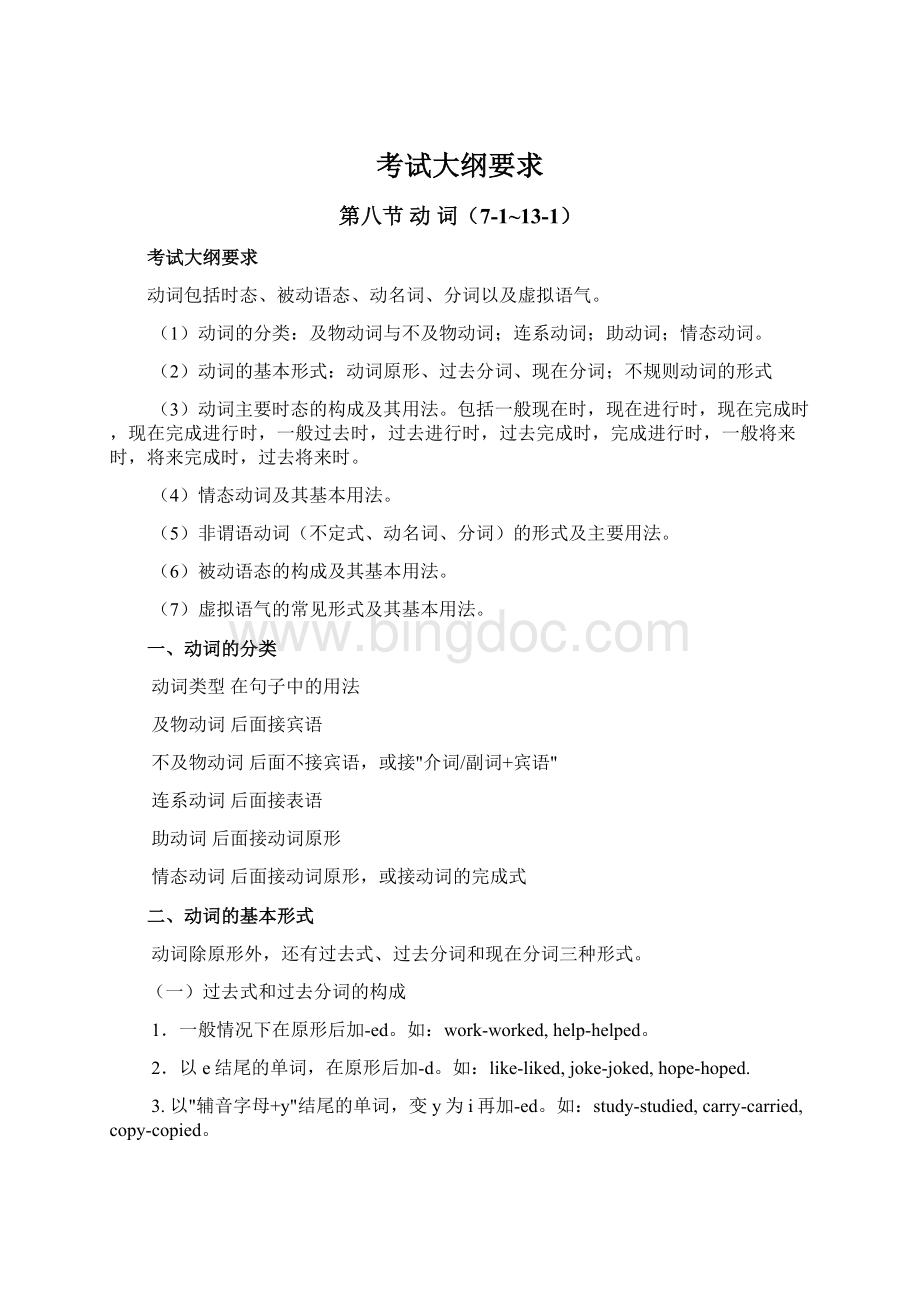考试大纲要求.docx
《考试大纲要求.docx》由会员分享,可在线阅读,更多相关《考试大纲要求.docx(51页珍藏版)》请在冰点文库上搜索。

考试大纲要求
第八节动词(7-1~13-1)
考试大纲要求
动词包括时态、被动语态、动名词、分词以及虚拟语气。
(1)动词的分类:
及物动词与不及物动词;连系动词;助动词;情态动词。
(2)动词的基本形式:
动词原形、过去分词、现在分词;不规则动词的形式
(3)动词主要时态的构成及其用法。
包括一般现在时,现在进行时,现在完成时,现在完成进行时,一般过去时,过去进行时,过去完成时,完成进行时,一般将来时,将来完成时,过去将来时。
(4)情态动词及其基本用法。
(5)非谓语动词(不定式、动名词、分词)的形式及主要用法。
(6)被动语态的构成及其基本用法。
(7)虚拟语气的常见形式及其基本用法。
一、动词的分类
动词类型在句子中的用法
及物动词后面接宾语
不及物动词后面不接宾语,或接"介词/副词+宾语"
连系动词后面接表语
助动词后面接动词原形
情态动词后面接动词原形,或接动词的完成式
二、动词的基本形式
动词除原形外,还有过去式、过去分词和现在分词三种形式。
(一)过去式和过去分词的构成
1.一般情况下在原形后加-ed。
如:
work-worked,help-helped。
2.以e结尾的单词,在原形后加-d。
如:
like-liked,joke-joked,hope-hoped.
3.以"辅音字母+y"结尾的单词,变y为i再加-ed。
如:
study-studied,carry-carried,copy-copied。
4.以重读闭音节、末尾只有一个辅音字母结尾的单词,双写末尾的辅音字母再加-ed。
如:
stop-stopped,prefer-preferred,admit-admitted,plan-planned.
有些动词的过去式和过去分词有特殊的形式。
cost-cost-cost
meet-met-met
catch-caught-caught
rise-rose-risen
drive-drove-driven
get-got-got/gotten
leave-left-left
smell-smelt/smelled-smelt/smelled
tell-told-told
take-took-taken
(二)现在分词的构成
1.一般情况下在原形后加-ing。
如:
go-going,carry-carrying,play-playing,answer-answering,ask-asking。
2.以不发音的e结尾的单词,去e加-ing。
如:
live-living,come-coming,dance-dancing,write-writing。
3.以重读闭音节、末尾只有一个辅音字母结尾的词,双写末尾的辅音字母再加-ing。
如:
sit-sitting,begin-beginning,permit-permitting,run-running,forget-forgetting.
有些动词的现在分词有其特殊形式。
如:
die-dying,lie-lying,tie-tying,picnic-picnicking.
三、动词的主要时态
(一)一般现在时
一般现在时表示经常性或习惯性的动作、现在的特征和状态、普遍真理等。
Galileosaidtheearthmovesaroundthesun.
一般现在时的谓语形式:
1.当动词为实义动词,如read,go,look时,谓语用动词原形,否定句在动词前面加donot,疑问句加助动词do。
常和always,often,usually,sometimes,everyday等表示时间的状语连用。
Igotoschooleveryday.
Ireadthenewspapersafterlunch.
Doyouagreewithme?
(agreewithsb.同意某人观点)
Idon'tquiteagreewithyou.
主语为第三人称单数时,动词后面一般加s(具体变化规则与名词变复数相同)。
否定句加doesnot,疑问句加does.
Myfathergetsupatsixeveryday.
Helovessports.
Doesithurt?
DoesMissWuteachusEnglish?
Themachinedoesn'trunsmoothly.
2.当动词为be时,谓语随人称和数的不同用am,is,are三种形式。
Oneisnotguiltyuntilheisproved.在被证明有罪之前,人都是无罪的。
Knowledgeispower.知识就是力量。
Sheisn'tafraidtogotoschoolalonenow.
AreyoufromYunnan?
(befrom来自……地方)
Whatshesaysistrue.
3.当动词为have,表示"有"时,谓语用have,主语为第三人称单数时,用has.否定句相应用haven't,hasn't,或don'thave,doesn'thave,疑问句将have,has提至主语前面或加助动词do,does.
Mysisterhasalotoftoys.
Shealwayshavealotofhomeworktodo.
Hasshe/Doesshehaveanymoneyonher?
Theydon'thave/haven'tmuchexperience.
当have作实义动词,如havealook,havebreakfast,havelunch,havesupper时,句子的谓语形式与其他实义动词相同。
Let'shavealookatthepicture.
Ialwayshavebreakfastathome.
Sheoftenhaslunchinthedinninghall.
always、often通常放在系动词之后,实意动词之前。
1.Itisanacceptedcustominourcountryformentoremovetheirhatswhenawoman______theroom.
A.enterB.entersC.enteringD.entered
wheh状语从句中的主语是第三人称单数,
答案B
2."I'mleavingnow."
"Makesure_______thedoor."
A.youlockB.you'lllockC.forlockingD.locking
makesure+动词原型或句子。
答案A
3.Jeancouldbeaveryattractivegirlbutshe________toherclothes.
A.paysnoattentionB.payingnoattention
C.waspayingattentionD.hadpaidattention
答案A
4."HowdoesAlmalikehernewwork?
"
"She_______withthehours."
A.can'tsatisfyB.isn'tsatisfied
C.doesn'tsatisfyD.hasn'tsatisfied
besatisfiedwith对……满意
答案B
(二)一般过去时
一般过去时表示过去某个时间发生的动作或情况,包括过去的习惯性动作。
常与表示过去的时间状语连用。
如:
aminuteago,yesterday,lastweek,in1990,duringthenight,inthosedays.用过去时时,说"过多少时间之后",一般用after,不用in。
一般过去时的谓语形式:
1.动词为实义动词时,谓语用动词的过去式,否定句在原形前加didnot,疑问句加助动词did.如:
Johnsuddenlyfellillyesterday.(fall-fell-fallen)
Mymotherdidn'tlookwellwhenIsawherlasttime.
Ithappenedafterfourdays.
DidtheygotoCanadalastweek?
Nothinghappenedsincethen.
Hewentoutjustnow.(justnow刚才)
Abookthatcostafewjiaoseveralyearsagoisworth30yuannow.
2.动词为be,主语是I或第三人称单数时,谓语用was,其他情况用were.如
Theywereclassmateswhentheyweretenyearsold.
Shewasonceadoctorbutnowshehasretired.
Whywereyouabsentfromschoolyesterday?
3.动词为have时,肯定句谓语用had.表示"有"时,否定句可用hadnot,疑问句将had提至主语前面,也可与have作实义动词时相同,即否定句用didn'thave,疑问句加助动词did。
如:
Theydidn'thaveanymoneyleftandtheycouldn'taffordthehouse.
Shedidn'thaveanyrestatnoonandcontinuedtowork.
DidyouhavedinnerwithMr.Wangatthatfamousrestaurantthedaybeforeyesterday?
Wehadabigfactoryfortyyearsago.
1.Johnwasfinishinghisassignmentswhenhisfather_______homefromwork.
A.cameB.comesC.hascomeD.iscoming
主句为过去时,状语从句也为过去时。
答案A
2.ThefirstzoologicalgardenintheUnitedStates_________inPhiladelphiain1874.(zoo)
A.hadestablishedB.hasestablished
C.wasestablishedD.established
考试时应先考虑句子是主动还是被动,然后再考虑时态。
动物园应该是被建
A、D都是主动语态。
答案C
(三)现在进行时
现在进行时主要表示现在或现阶段正在进行的动作。
可与now,atpresent,atthismoment,thesedays等时间状语连用。
现在进行时的谓语形式:
am/is/are+现在分词。
Whatareyoudoing,Jack?
We'retryingtoplanourfuture.
Thetrainisnowrapidlyapproachingthecity.(approach接近)
Lifeischangingallthetime.
Thewomanwhoisstandinghereismymother.
动词go,come,leave,stay,arrive,die等用于进行时态中,可以表示将要进行的动作。
Thebusisleaving,pleasehurryup.
It'sgoingtorain.Don'tforgettotaketheumbrella.
Myuncleiscomingtoseeusthisweekend.
TheboyisleavingforBeijingtomorrow.(leavefor动身)
1.Healthexpertsinmanycountriesstill________theirideasabouttherelationshipsbetweenourfoodandourhealth.
A.havetestedB.testedC.aretestingD.test
still(仍旧)一般用于进行时。
still一般放在系动词后面,实义动词前面。
答案C
2.Whatisthisnoise?
Tellmewhat_______here.
A.wentonB.goesonC.isgoingonD.willgoon
答案C
(四)过去进行时
过去进行时主要表示过去某个时刻或一段时间内正在进行的动作。
过去进行时的谓语形式:
was/were+现在分词。
Mysonwaspracticingthepianothistimeyesterdayevening.
WhenIcalledhim,hewashavinghisbreakfast.
Whilewewerehavingameeting,Marycameinandtoldustheterriblenews.
Iwasleavingtheroomwhenthetelephonerang.
1.Jameshasjustarrived,butIdidn'tknowhe_____untilyesterday.
A.willcomeB.wascomingC.hadbeencomingD.comes
现在完成时表明的是过去的动作对现在的影响或持续到现在。
hadbeen过去完成时,表示过去的过去。
wascoming用过去进行时表示将要的动作。
答案B
2."WhatwereyoudoingwhenAnnaphonedyou?
"
"Ihadjustfinishedmyworkand_______totakeabath.'
A.startingB.tostartC.havestartedD.wasstarting
whatwereyoudoing提问的是过去进行时。
答案D
(五)一般将来时
一般将来时主要表示准备做的事、将要发生的动作情况、按计划安排要发生的事。
一般将来时的谓语形式:
1.am/is/aregoingto+动词原形
2.will/shall+动词原形(shall用于第一人称)
3.am/is/are+不定式
We'llhaveeggsandtoastforbreakfastthismorning.
Howareyougoingtospendyoursummervacation?
Ithinkit'sgoingtorain.
Wearegoingtothezootomorrow.
Thefactoryistogointoproduction.
ThelineistobeopenedtotrafficonMayDay.
Themachinewon'twork.
Themeetingwon'tlastlong.
beaboutto可表示即将做某事。
Heisabouttoleave.
Mymotherisabouttoretire.
一般将来时有时还可以用来表示一种倾向。
Cropswilldiewithoutwater.
WheneverIhavetime,I'llgoandseeyou.
Whoeverfailstoseethiswillmakeabigmistake.
Oilwillfloatonwater.
用ShallI…?
Shallwe…?
开头可以表示征求对方的意见。
肯定回答用"Yes,please"或"Pleasedo";否定回答用"No,pleasedon't"等来回答。
--ShallIclosethewindow,it'stoocoldhere.
--Yes,please.(No,Pleasedon't.)
--Shallwecallataxi?
--Yes,let's.(No,Idon'tthinkweshall.)
时间和条件状语主句是将来时,从句中一般不能用将来时态,而用现在时态代替。
Lipingwillletyouhavethebookwhenheisthrough.(主动语态里let后面再出现动词省略to)
Weshallhelpyouifyouaskus.
I'llaskmymotherassoonasshecomes.
Itwillbesixyearsbeforewemeetagain.
Shewillmissthetrainunlessshehurriesup.
1.Nomatterhowmuch_______,itwellbeworthit.
A.willthewatchcostB.thewatchwillcost
C.doesthewatchcostD.thewatchcosts
状语从句主句将来时从句用一般现在时。
howmuch+主语+谓语
单问表的价钱:
Howmuchdoesthewatchcost?
答案D
2.Althoughhepromisedtochange,I'mstillwonderingwhenhe______abletoputhisheartintohisstudies.
A.wasB.willbeC.beD.were
beabletodo
选项C中when是时间状语从句,谓语不直接跟系动词be。
答案B
3."WillSusangetherPh.D.?
"
"Itislikelythatshe_______."
A.willB.doesC.willdoitD.getsit
用将来时提问直接用将来时回答即可。
答案A
4."DidyouvisitGracelastsummer?
"
"No,butI______herovertheChristmasvacation."
A.willseeB.beseenC.haveseenD.havebeenseeing
答案A
5.Mr.AndMrs.ZhangaregoingtoBrazilnextweekandthey_______toMexicolaterinthemonth.
A.willgoB.wouldgoC.wentD.havegone
答案A
6."Aretheregoingtobemanypeopleatyourpartytoday?
"
"Wehopethat_________."
A.therewillbeB.thereisC.thereareD.therearegoingto
答案A
7."Whenwilltheplanearrive?
"
"I'lltellyouwhenI_______."
A.willfindoutB.findout
C.amfindingoutD.havebeenfindingout
时间状语从句和条件状语从句中主句为将来时则从句用一般现在时。
findout查出原因
find发现lookfor寻找
答案B
(六)过去将来时
过去将来时主要表示在过去某个时间打算要做的事,或从过去某个时间看来将要发生的事。
过去将来时常用于间接引语中。
过去将来时的谓语形式:
1.was/weregoingto+动词原形
2.would/should+动词原形
3.was/wereto+动词原形
Weneverimaginedthatmysisterwouldbecomeadoctor.
Hesaidhewouldcomebackthenextday.
Ithoughtyouwouldn'thaveanyobjectiontoit.(objectiontosth.反对某事)
Weweresurewewouldwinfinalvictory.
Heinformedusthetrainwastoleaveatsix.
Ididn'tknowwhentheyweregoingtocomeagain.
Hewasabouttogettherewhenitbegantorain.
YouknewIwouldcome.
1.Theythoughtit________funtotakethecar.
A.canbeB.willbeC.wouldbeD.hasbeen
答案C
2."HasJohnfinishedthereport?
"
"No,heknewthathe_________timetofinishitbytomorrow."
A.won'thaveB.willhave
C.wouldn'thaveD.shallnothave
答案C
(七)现在完成时
现在完成时表示过去发生的但对现在有影响的动作,或从过去某个时间开始一直持续到现在,可能还会持续下去的动作或状态。
现在完成时的谓语形式:
have/has+过去分